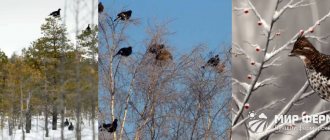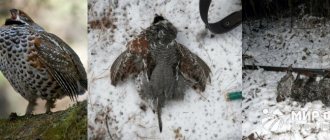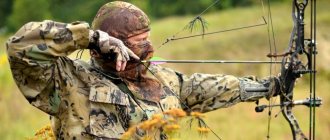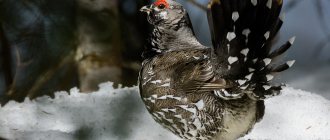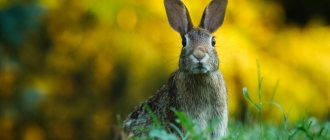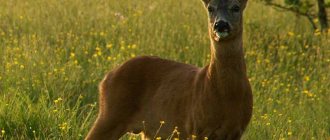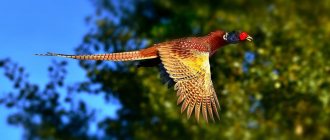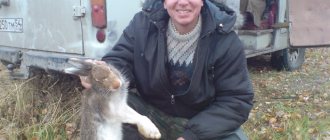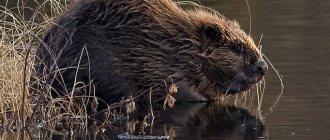Hazel grouse hunting season
The hunting season for hazel grouse opens closer to autumn, when the young animals still follow their mother in brood, but have almost reached the size of an adult bird and are slowly beginning to separate. Usually the official start of hunting for such game is on the third Saturday in August, but in reality it is better to start in mid-September. During this period, the hazel grouse begins autumn mating in order to form new married couples by winter. Then it becomes easier to find him by his calling whistle and flitting between the trees.
The hunting season for grouse lasts until the last day of February. In the spring, the final formation of pairs and the breeding of new offspring begins, which continues until the beginning of autumn. At this time, hunting it is prohibited.
Opening dates for hunting for fur-bearing animals 2020
| Chipmunk | from the third Saturday of August to October 31 |
| Sand squirrel (yellow) | from March 20 to May 20 |
| Mole (common, Siberian, small, Caucasian) | from June 1 to October 25 |
| Marmots (steppe, gray, Kamchatka), ground squirrels (large, small, Transbaikal, speckled, cross-cheeked, long-tailed, American, Caucasian, with the exception of the sandstone ground squirrel) | from July 1 to September 30 |
| Hare (hare, hare, tolai, Manchurian), wild rabbit, raccoon dog, fox, corsac dog | from September 15 to February 28 (29) |
| Muskrat, water vole | from October 1 to April 1 |
| Beaver (European, Canadian), otter | from October 1 to February 28 (29) |
| Sable, mink (European, American), weasel, squirrel, flying squirrel, lynx, wolverine, marten, marten (forest, stone), ermine, polecat (forest, steppe), weasel, striped raccoon, solongoi, wild cats | from October 1 to February 28 (29) |
| Arctic fox | from October 1 to April 1 |
| Badger | from August 15 to October 31 |
Did you like it? Share on social networks!
We recommend reading
- Dates for spring hunting 2020 for duck and goose by region: hunting rules and production standards
- How to renew a permit for a hunting weapon in 2020 - all about this procedure
- Permit for hunting weapons 2020
- ← How to renew a permit for a hunting weapon in 2020 - all about this procedure
- Criteria for choosing a hunting rifle for a beginner →
Habitats
The hazel grouse is exclusively a forest dweller. Being primarily a herbivore, it finds its main food sources there. At different times these are blossoming buds, young leaves and grass, flowers, seeds, various berries, closer to winter - earrings, tips of branches and buds of alder, birch, etc. Therefore, he practically never leaves the forest; he leads a rather sedentary lifestyle, rarely leaving his plot and only moving to new sources of food in winter.
Important! Typically, a pair of hazel grouse occupies a section of forest with a radius of about 200 meters, which they adhere to until the onset of cold weather.
He primarily loves dark coniferous and coniferous-deciduous forests with dense coniferous young growth or deciduous undergrowth. Preference is given to damp areas of the forest, the vicinity of rivers, streams, ravines and lowlands. He also likes to stay close to birch trees, thickets of aspen and alder, which provide him with food at different times of the year. Among tall pine forests it can only be found if there is a dense spruce undergrowth.
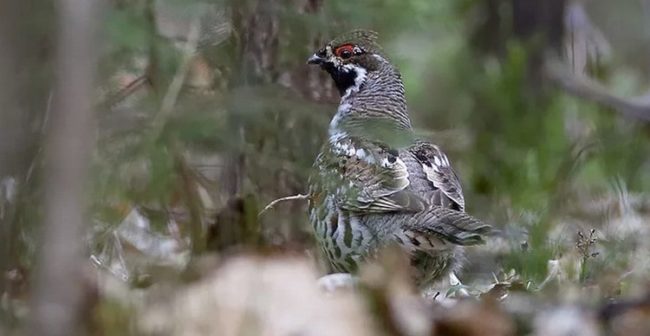
Hunting rules
In order for your hunt for hazel grouse to be successful, and for more than one season, you should take into account the characteristics of this bird and adhere to a number of simple rules :
- When hunting in late summer and early autumn with a decoy, it happens that you come across a whole brood at once; shooting in such cases is considered unsporting; it is better to wait until it scatters and only then take individual individuals;
- In addition, in such a situation, try not to shoot the female, usually this is the largest bird in the brood;
- For the same reason, spring hunting is prohibited, since the male and female hazel grouse are very similar and will react equally actively to the sound of a decoy;
- The preservation of females after breeding, in autumn and winter, is not so important, since the hazel grouse is a paired bird, and the prevalence of either sex still leads to a reduction in the population in the region;
- Since the hazel grouse stays in pairs and groups, when approaching, several individuals can take off simultaneously to disperse the attention of the predator. In such cases, try to keep only one bird in mind;
- For the same reason, having shot or scared off one, immediately look for the second;
- If a hazel grouse flies up attracted by a decoy, there is no need to shoot it in flight. Even when he sees you, he will still sit down to better examine the danger. This gives 3 to 5 seconds per shot;
- The best weather for hunting is calm, without wind or rain. In such weather, the hunter can hear the bird far away and clearly and can see it better;
- When searching for a bird, first of all you need to focus on the places where the food characteristic of it at this time of year grows, berry fields, alder thickets, birch trees, etc.;
- In case of danger, the hazel grouse first flies close, 30 - 50 meters, then further, then even further. This gives you a chance to spot and shoot him after the first flight;
- It always flies in a straight line, which makes searching easier;
- After the flight, sit on a tree closer to the trunk to hide, then higher, next time even higher;
- The hazel grouse prefers spruce and sits on it first; this must be taken into account when luring or looking for it.
Find out what shot to shoot hazel grouse with
Differences at different times of the year
The behavior of hazel grouse, and therefore hunting for it, is somewhat different at different times of the year.
Autumn hunt
By the beginning of autumn, young hazel grouse still adhere to the brood, gradually scattering and gaining experience. This is the only period when he will be able to hunt with a dog; later it will be difficult. From mid-summer to cold weather, it is recommended to look for hazel grouse in various berry fields. At the same time, he tries to stay near the ground, but the colder it gets, the higher he moves into the trees.
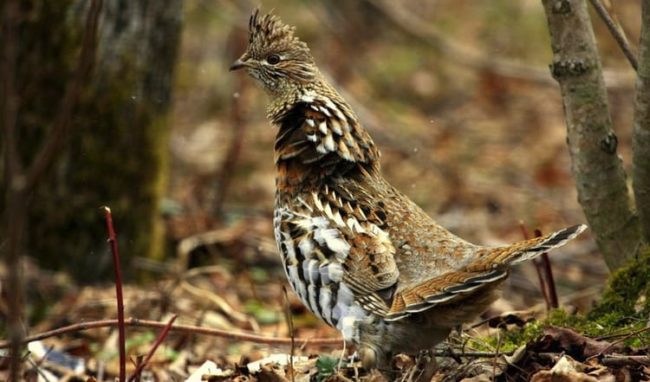
From September, at the end of the summer molting, the time of autumn mating begins, when the birds are looking for a new mate with whom they may overwinter, and from next spring they will breed. This allows you to actively hunt with a decoy and search for birds by their roll call. Therefore, in the fall they hunt with a decoy, from the approach, by a surge, with a dog.
Winter hunting
With the arrival of frost, the hazel grouse spends most of the day in the trees. It moves closer to birch, aspen and alder trees, where it feeds on catkins, buds and tips of twigs. To rest and spend the night, it hides in the lower branches of fir trees or at their base. With the fall of deep snow and the arrival of even greater frosts, he moves into the snow, where he hides in holes . In severe frosts, he can spend most of the day there. Moreover, the birds make holes not far from each other, sometimes gathering in whole groups.
In winter, they hunt from the approach, and with the onset of deep snow, they hunt in holes.
Comments
- Vasily M. 02/25/2016 at 14:42 Good article, it will definitely be useful for a novice hunter so as not to mess things up without looking into things! My men and I love to go wild boar hunting, so in the fall we’ll go for some prey. Author, thank you for the calendar, it will come in handy, I’m bookmarking it!
Reply Vladimir 04/08/2020 at 13:15It is misleading to hunt from the approach, that is, search for game, on a forest, if you don’t know why, write, capercaillie, woodcock, this does not mean that perhaps you do not have such game,
Answer
Every year I stumble over the thought that another shooter is lying in the reeds. What methods do you see and do you see in general for combating careless hunters who hold gunpoint and shoot knowing that they will not reach the target?
Answer
- Tracy 25.11.2016 at 15:10
I'm relaly into it, thanks for this great stuff!
Answer
Eh, but here you can’t go moose hunting in the fall. We will wait for the winter hunt. Something didn't work out this winter...
Answer
This article will be useful not only for novice hunters, but also for old people to refresh their memory.
Answer
Thanks to the author for the information! It would be great if such articles were included in permits.
Answer
Useful article, more of these.
Answer
Not all hunters use com and for various reasons! Therefore, it is advisable to release the calendar in the form of a memo to hunters and distribute it through the association of hunters when obtaining licenses to shoot a particular species, of course not for free if the author is not too rich
Answer
In our office, brochures with the calendar are given out for free! Who knows who sponsors this printed product, but it’s nice! You can always look and plan your weekend. And in the off-season you can catch crucian carp, which is also a nice catch)
Answer
To be hunted like that, fucking sadistic hunters....!!!
Answer
- Anonymous 08/16/2019 at 21:50
Woodpecker, don’t get involved in something you don’t understand! And be careful with profanity!
Answer
The only adequate comment, the rest are horny flayers!
Answer
Vitaly 10.03.2020 at 14:21
Why waste attention on a woodpecker? He obviously ended up on the wrong site, so he got lost))
Answer
THANKS WE WILL KNOW!!!
Answer
The hunter's calendar was written by a man who doesn't know a damn about this very hunt! In the spring, goose hunting (including female geese) is allowed in most regions of Russia. The same applies to waders - woodcock translated from German as wood sandpiper. I didn’t even bother to read this nonsense any further. Hello hunters and have a nice opening.
Answer
- Ivan 02/06/2020 at 10:49
Let's give some examples. Where is it legal to hunt female geese?
Answer
Andrey 03/07/2020 at 09:32
In Len. region, except for gray goose, the norm is 2 pieces per day for permission
Answer
In Kamchatka, in the spring I took a ticket myself, 2 geese 5 drakes are the norm per day
Answer
Add a comment
latest comments
Dmitry: Who knows for sure whether something matters for re-registration...
Leonid: Currently I am almost 75 years old. By law it is necessary to extend...
barraquda: come in “old man”...
Tatyana: Dear people. Well, take your pick, for God’s sake I don’t have room for...
Paul Hogan: Opening of autumn waterfowl hunting in the Penza region...
: When is hunting opening in the Tyumen region?…
Aler: In Kamchatka, in the spring I took a trip myself, 2 geese 5 drakes are the norm per day...
Maria: Hello, please tell me if my husband is renewing the ROC for Karabi...
Evgeniy: Hello, similar situation. I would like to know how she r...
Vadim: Tell me, a year before the license expires, you can...
Ivan: good question, quality)…
Dima: question...
Survey
Hunting methods
Now let's take a closer look at the most common hunting methods.
With decoy (in short, there is a separate article)
Hunting with a decoy is the most popular and favorite way of autumn hazel grouse hunting. To a first approximation it looks like this. The hunter moves around the places where these birds are likely to be found, periodically making calling sounds with a decoy. They mainly imitate the female's cry as it is more productive. Having heard the response, he chooses a place for an ambush, hides and continues to periodically beckon until the attracted hazel grouse arrives, exposing himself to the shot.
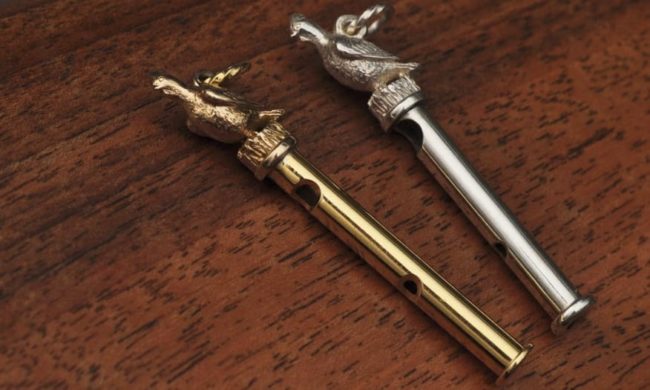
In an area densely populated by this bird, in calm, clear weather, you can attract by simply taking a favorable, advantageous position. In addition, the decoy can also be used when hunting from the approach.
From the approach
Trying to behave secretly, the hazel grouse can let the hunter get very close. This is what this hunt is based on. Realizing that danger is approaching him, the hazel grouse noisily flies up 10 - 15 meters from the hunter. It flies in a straight line, at first not far, usually 30 - 50 meters. After which it sits low on the branches and tries to briefly examine the danger. This pause allows the hunter to take aim and make the right shot. If this does not happen, the hazel grouse flies to a much greater distance, and then even further, while sitting higher and higher. However, he flies again in a straight line, which leaves a chance to find him again.
It happens that several birds fly away at once, distracting attention, but you need to try to pursue one individual.
When searching, they go around the places where it is most likely to be, berry patches, other feeding areas, dense spruce forests, etc. You can also navigate by bird call, helping yourself in your search with a decoy. You need to walk as quietly as possible so that the bird flies closer to the hunter. It is useless to look for him in the thick bushes and grass, but he will make himself known by taking off noisily.
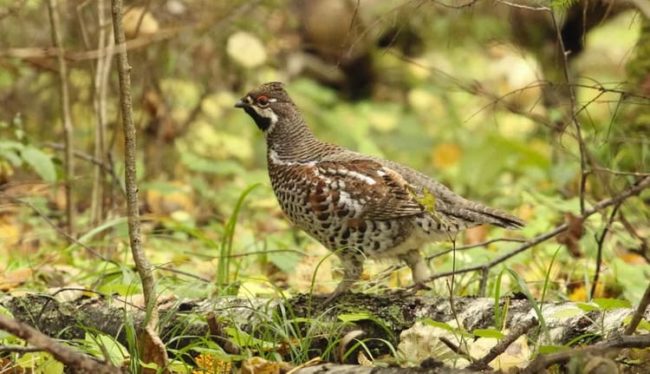
With the beginning of winter, in light snow, you can hunt from the approach in thickets of young aspen, etc., where the birds already feed for the winter.
Surge
Drive hunting is carried out by a group of hunters, divided into two teams. Having found places inhabited by hazel grouse, the team of hunters forms a line, and the team of beaters goes deeper into the forest. There, they lined up and walked towards the first team, creating more noise. The alarmed birds begin to move away from danger, fluttering further and further, and come under fire from the team of hunters. They shoot mainly at birds that have landed on branches in front of a new danger, and only in rare cases, at birds flying over them.
Drive hunting is also possible for two people, in late autumn along the beds of forest rivers, streams or ravines. By this time they gather in precisely such places. The tactics here are as follows: one hunter sits in ambush in a specified place, and the second, having moved away along the riverbed for some distance, 0.5 - 2 km depending on the terrain, goes in its direction, hunting hazel grouse along the way from the approach . As a result, birds running away from the beater will fly out at the shooter sitting in ambush. In such cases, the hazel grouse tries to stick to habitats and feeding areas that run along the bed of reservoirs.
With a dog
Hunting a hazel grouse with a dog, a husky or a pointer, is quite problematic, since this bird cannot tolerate either a dog's stance or barking, and immediately breaks away to hide. You can hunt this way only in early autumn, for young animals, which, due to inexperience, may not respond to a pointer’s stance or barking.

The best time of day for hunting with a dog is early morning, when the young hazel grouse feed and disperse as they do so. Then some young individuals will react to the dog's stance and will not immediately run away. The hunter looks for the dog and determines the direction towards the bird by its stance. A shot with this approach is usually made flying into the already noisily taking off grouse.
Laika, for hazel grouse, can only be used by an experienced one, specially trained for such a hunt. Even young hazel grouse immediately hide from an ordinary husky. A proper husky should report the discovery of a bird with two or three soft sounds, without particularly concentrating its attention on the bird. It’s even better if she silently returns and leads the hunter to the hazel grouse. They are guided towards the bird by the dog’s gaze; in this case, if you approach quietly, you can shoot at the one sitting.
In any case, adult individuals fly away from the dog immediately. Therefore, later in the fall, the young animals also gain experience, and hunting with a dog becomes futile.
Important! According to existing hunting rules, hunting hazel grouse with snares and other traps is strictly prohibited.
Previously, these means were used for commercial hunting. Now this method can be useful and save if you get into a critical situation in the forest.
Loops are made from fishing line, or any thin strong thread, which are placed on branches or on the surface so that the bird, moving along the ground, is caught in the loop by the legs or neck and, by inertia, tightens it.

A more complex version of the snare is the spring, when the loop is attached to a young tree bent to the ground or an elastic branch, captive to the guard. Berries are usually placed in the center of the trap. When the guard is touched, the branch straightens sharply, catching the bird by the leg with a loop and lifting it above the ground. Similar snares can be made on tree branches, using long elastic branches. The advantage of this type of fishing is that the caught game is less spoiled by predators and rodents.
The next trap option will be a pressure trap. To do this, make a flooring of several logs supported by an easily knocked out stick. Bait in the form of berries is poured under it. When the support is knocked out, the bird is crushed under the weight of the logs.
All these traps must be bypassed at least once every 2 days, otherwise the game will be spoiled by birds, rodents, small predators and other forest inhabitants.
From the holes
If the hazel grouse still leaves many tracks in the first snow, tearing it apart in search of food on the ground, then when deep snow falls, it becomes much more difficult to find the bird. But these difficulties make the hunt for him even more exciting. In winter, the hazel grouse's behavior is quite monotonous. It moves to young growth of birch, alder or aspen, along rivulets, streams or in clearings.
Hunting hazel grouse in rainy weather and strong winds
In autumn, the hazel grouse's daily routine does not change much with weather changes. At night he sleeps, in the morning - the first feeding, in the afternoon he rests again, then the evening feeding and sleep. If at this time the male hears the female’s voice, bad weather will not stop him. How the hunt goes is another matter. In the rain, and especially in strong winds, both the voice of the hazel grouse and the sound of the decoy are hard to hear.
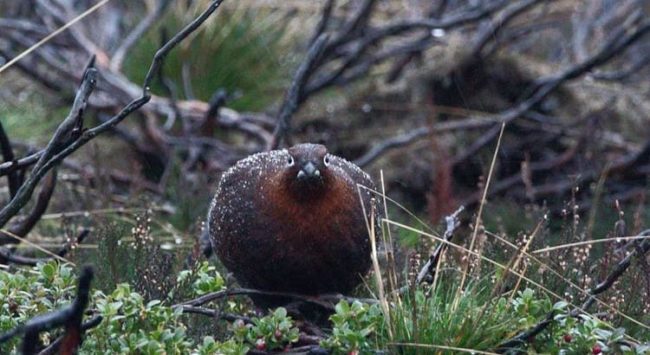
If a hazel grouse goes to the decoy, its hearing is excellent, but it is difficult to lift it from its place, then its approach will most likely go unnoticed. In such weather he rarely makes a voice, the noise of his wings is hard to hear, and then he tries to move on the ground. In such conditions, he will see and hear you much earlier than you will hear him.
Important! It must be taken into account that in high humidity the sound of the decoy will change, so for such conditions, in fog, after rain, or simply in damp weather, you need to have a separate, “wet” decoy with a different timbre.
Hunting from the approach in bad weather is impossible, since the hazel grouse climbs into the thick of the spruce forest, under the thickest branches, and sits very tightly. It is almost impossible to pick it up, and you simply won’t notice it there. Even after taking off, he tries to immediately hide again in the thick of the spruce branches. In windy weather, hunting from the approach is generally possible, but the forest for it should be chosen higher, the stronger the wind, but it will still be difficult to catch the noise, direction of flight and landing of birds.
After night rains, hunting can be successful, but you need to wait until the morning wind removes the heavy dew from the branches.
But just in cloudy weather, hunting is quite prey, since it is easier to look out for birds on the branches, and they later notice a hunter passing towards them.
What to go with upland game?
According to the hunting rules established on the territory of our state, this group of birds includes woodcock, hazel grouse, black grouse, wood grouse, tundra and ptarmigan. In addition, this regulation contains a list of weapons permitted for use. This includes:
- Smooth-bore and rifled firearms, the caliber of which does not exceed 6.5 millimeters.
- Any traps, including cages and traps.
- Combination firearms with a caliber of no more than 6.5 millimeters, including models with interchangeable or interchangeable rifled barrels.

By the way, there are also some subtleties here. For example, woodcock can only be hunted with a smooth-bore firearm, but hazel grouse can be tracked with pneumatic weapons, the muzzle energy of which does not exceed 25 J.

